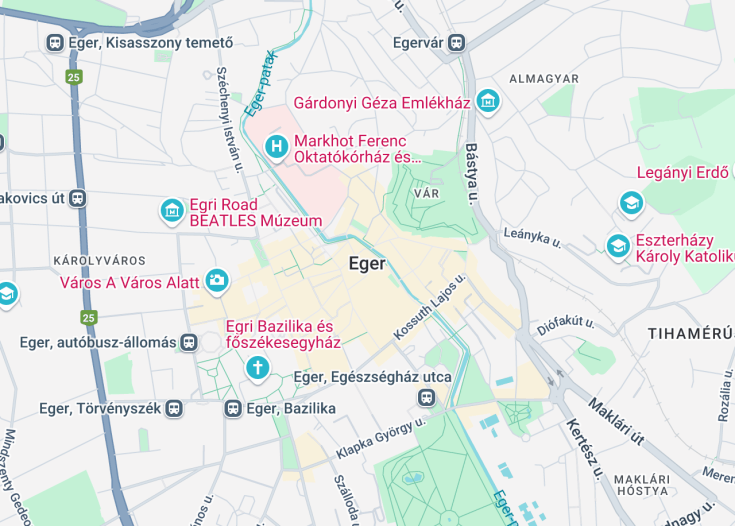Eger, nestled in the valley of the Bukk Mountains in northern Hungary, is a gem steeped in history and culture. Known for its therapeutic thermal waters, historic Eger Castle, and the splendid Baroque architecture of its town center, this city offers a unique blend of relaxation and cultural exploration.
Eger is also famous for its wine-making, especially the renowned “Egri Bikavér” (Bull’s Blood) red wine, making it a must-visit destination for oenophiles and history buffs alike.
When visiting Eger, ensure to explore the Eger Castle, where you can experience panoramic views of the city and delve into rich historical tales.
Don’t miss a chance to visit the Valley of Beautiful Women, just outside Eger, perfect for tasting the local wines directly from the cellars.
Top things to do & see in Eger
Select the following sights and activities to discover best tickets and tours available in Eger.
Eger: A Historical Gem in the Heart of Hungary
| Country | Hungary |
| Time in Eger | GMT+1 |
| Language spoken | Hungarian |
| Population | 53,825 (source: latest census) |
| Currency | Hungarian Forint (HUF, Ft) |
| Airports |
|
Eger is a city of extensive history, characterized by the thermal baths and Turkish minarets that tell tales of past occupations and the famous Eger Castle that stood firm during the 1552 siege by Ottoman forces.
This small yet vibrant city in northern Hungary unites architectural beauty with a lively cultural scene. Known for its vineyards, Eger is the birthplace of the robust red wine, Egri Bikavér, and invites visitors to taste this and other local specialties in its numerous wineries and wine cellars scattered around the picturesque Szépasszony Valley.
Where is Eger?
Eger is located in the northern part of Hungary, nestled in the Eger Stream valley, between the Mátra and Bükk mountains.
Distances:
| Route | Distance by car | Time by car |
|---|---|---|
| Budapest to Eger | 86 miles (139 km) | 1 hour 50 minutes |
| Debrecen to Eger | 77 miles (124 km) | 1 hour 35 minutes |
| Szeged to Eger | 166 miles (267 km) | 3 hours 10 minutes |
What is Eger famous for?
Eger is renowned for its historical significance and architectural landmarks such as Eger Castle, the gorgeous Dobó Square, and the Minaret. It’s also famed for its wines, especially the “Bull’s Blood” of Eger (Egri Bikavér).
History
Early Settlement and Medieval Period (10th-17th Century)
The history of Eger, one of Hungary’s most esteemed cities, begins in the early Medieval Period. The region, characterized by its fertile valleys and strategic location, attracted early settlers, cementing its role as a key religious and economic center. The establishment of Eger Castle in the 13th century marked the city’s importance as a fortification against invaders, including the Mongol onslaught in 1241. By the 16th century, Eger had become a bishopric, enhancing its role in religious and cultural activities within the Kingdom of Hungary.
Ottoman Occupation and Habsburg Monarchy (16th-18th Century)
In 1596, Eger fell into the hands of the Ottoman Empire, an occupation that lasted nearly a century. During this period, the city was transformed culturally and architecturally, with the introduction of Turkish baths and minarets. However, Eger is perhaps best remembered for its defiant stand during the 1552 siege, where the outnumbered defenders repelled a vast Ottoman army, a turning point celebrated in national lore. The city was reclaimed by the Habsburgs in the late 17th century, ushering in a period of reconstruction and Baroque transformation, with magnificent structures that still define its skyline.
Modern Era (19th Century to Present)
The 19th century brought industrialization and the establishment of the Eger railway, which connected the city with major industrial hubs, enhancing its economic importance. Despite the impacts of the World Wars, Eger preserved much of its historical charm and architecture. Post World War II, the city saw significant restoration projects, particularly in reviving its Baroque heritage. Today, Eger is celebrated not just for its historical significance but also as a center of education, culture, and wine production, notably the Bull’s Blood of Eger, which has helped reinvigorate its local and regional economy.
Visit Eger
What to see and do in Eger, Hungary
Eger invites historians and casual explorers alike with its rich tapestry of architectural and cultural landmarks. Key attractions include Eger Castle, a testament to medieval fortitude and the site of the historic 1552 siege.
The city’s Minaret offers panoramic views, while the Eger Basilica stands as a magnificent example of classical architecture. The Valley of the Beautiful Women is essential for wine enthusiasts, offering tastings of the region’s famous Bull’s Blood wine. For relaxation, the Eger Thermal Bath provides a perfect blend of leisure and healing.
- Eger Castle
- Eger Minaret
- Eger Basilica
- Valley of the Beautiful Women
- Eger Thermal Bath
Festivals and Events in Eger
Eger’s calendar brims with cultural festivities, reflecting its rich heritage and vibrant community spirit. Key events include the Egri Bikavér Festival, celebrating its famed Bull’s Blood wine in July, and the Baroque Days in September, a reenactment of 18th-century life with music, dance, and costumes. The city also hosts the Eger Spring Festival, which ushers in the season with classical concerts, folk dance, and art exhibitions.
Best time to visit Eger
The best times to visit Eger are late spring and early autumn, particularly from May to June and September to October, when the weather is temperate, perfect for exploring the outdoors and participating in local festivals.
Is Eger worth visiting?
Eger is undoubtedly worth a visit for its compelling blend of history, culture, and natural beauty. The city’s storied past is visible in its vast array of historical sites, from ancient castles to Baroque cathedrals.
Additionally, Eger’s wine culture offers a tantalizing experience for oenophiles. Coupled with its warm hospitality and scenic landscapes, Eger presents a fascinating outing for any traveler.










